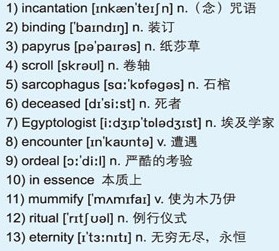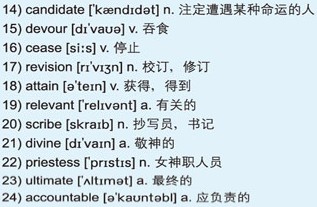千百年来,人类不断在问一个问题:我们死后会怎样?古埃及人认为他们找到了答案——被制成木乃伊之后,他们要踏上一次危机四伏的漫长旅途,最终到达永恒的极乐世界。但要到达那里,他们需要一本写有咒语的指南,那就是埃及的《亡灵书》(或称《死亡之书》、《死者之书》)。
藏有大量古埃及文物的大英博物馆正在举办《死后生活之旅:古埃及的亡灵书》(Journey Through the Afterlife: Ancient Egyptian Book of the Dead)展览,展期为2010年11月4日至2011年3月6日,有兴趣的同学可以访问博物馆的网站(www.britishmuseum.org),了解这次展览的内容。
Ancient Egypt was a land of mysteries, and one was the collection of prayers, spells, 1)incantations, and instructions known as the Book of the Dead.
古埃及是一片神秘之地,这里有一件神秘之物,它就是集祈祷文、符咒、咒语念诵和指导说明于一体的《亡灵书》。
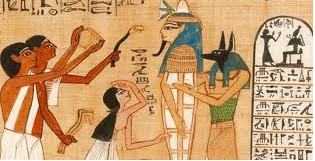 For one thing, the Book of the Dead was not in fact a book, since the Egyptians didn't have book 2)binding. It was a 3)papyrus 4)scroll that was placed in the 5)sarcophagus with the 6)deceased, and texts from it were also often written on the walls of the tomb and inside the sarcophagus.
For one thing, the Book of the Dead was not in fact a book, since the Egyptians didn't have book 2)binding. It was a 3)papyrus 4)scroll that was placed in the 5)sarcophagus with the 6)deceased, and texts from it were also often written on the walls of the tomb and inside the sarcophagus.
首先,《亡灵书》不是指某一本书,因为当时的埃及人没有书籍装帧技术。它是一份随亡者一同放入石棺内的纸莎草卷轴,上面的文字往往也会写在坟墓的墙壁上和石棺内。
For another, the Egyptians themselves didn't call the collection the Book of the Dead. That was a name given by German 7)Egyptologist Karl Richard Lepsius in 1842 when he published some of the texts.
再者,埃及人不把它称作《亡灵书》。这个名字是1842年德国埃及学家卡尔·理查德·莱普修斯在发表其中一些文字时创造的。
The Egyptians believed that when a person died, he still had a lot of work to do. What? Are you kidding? He had to make a long journey to paradise and 8)encounter a series of 9)ordeals on the way. The Book of the Dead contained the prayers and spells—and instructions for how to use them—that he would need on the trip; a sort of afterlife travel guide.
埃及人认为人死后还有很多事情要做。什么?你是在开玩笑吧?他要踏上通往天堂的漫长旅途,期间会遇到一系列严酷考验。《亡灵书》包含了他一路上需要用到的祈祷文和咒语,以及它们的操作方法;相当于一本死后旅行指南。
The Egyptians believed that if the person made it to the afterlife, his soul could come out of the tomb during the day and, 10)in essence, live again. He could enjoy all the same things he had in life. The Egyptians had a complicated view of the soul. Every person had a ba, which was like his personality, and a ka, which was his life force. The ba was dependent on the physical body, and that's why Egyptians were 11)mummified. After all the proper funeral 12)rituals and after the person made it to paradise, the ba and the ka were united to become the akh, or the completed soul. The akh was a blessed spirit that could then live the good life for 13)eternity.
埃及人相信,如果一个人成功到达来生,他的灵魂会在日间走出坟墓,实质上就是重生。他可以享受生前拥有的一切。埃及人对灵魂的理解十分复杂。每个人都有“巴”(类似于个性)和“卡”(生命力)。“巴”依赖于肉身,所以埃及人要制作木乃伊。当正确完成所有葬礼仪式、人到达天堂之后,“巴”和“卡”会结合在一起,成为“阿赫”,即完整的灵魂。“阿赫”即为神所佑的灵魂,从此可以永远过上美好的生活。
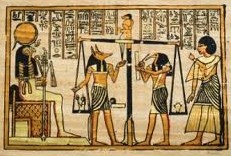 But first there was one last ordeal for the 14)candidate, and that was the weighing of the heart. Before Osiris, who was the god of the underworld, and several other judges, his heart was placed on a scale. It was weighed against a feather, which represented justice. If his heart was free from sin, the scale would balance and he was welcomed into paradise. But if his heart was heavy with sin, it was immediately 15)devoured by a terrible monster, and he was out of luck. He 16)ceased to exist, an unthinkable disaster to an Egyptian.
But first there was one last ordeal for the 14)candidate, and that was the weighing of the heart. Before Osiris, who was the god of the underworld, and several other judges, his heart was placed on a scale. It was weighed against a feather, which represented justice. If his heart was free from sin, the scale would balance and he was welcomed into paradise. But if his heart was heavy with sin, it was immediately 15)devoured by a terrible monster, and he was out of luck. He 16)ceased to exist, an unthinkable disaster to an Egyptian.
但在此之前,这位接受命运选择的人要面对最后一个难关,那就是称量心脏。在冥王奥西里斯以及数位审判官面前,他的心脏被放到一个天平上,与一根代表正义的羽毛相比较。如果他的心无罪,天平则平衡,他便能进入天堂。但如果他的心因为罪孽而沉重,那么其心脏马上会被一只恐怖的怪兽吞食,他就要遭殃了。他将从此消失,这对一个埃及人来说是无法想象的灾难。
Egyptian civilization lasted for a long time, and the Book of the Dead went through 17)revisions. The Pyramid Texts注1 were written during the Old Kingdom, about 2500 to 2000 BC. During that time, only the Pharaoh could live after death, so the writings belonged to him and were written on the inside walls of his pyramid. By the Middle Kingdom, about 2000 to 1500 BC, everyone could 18)attain the afterlife, and the Book of the Dead contained new writing as well as writing from the Pyramid Texts. Not only was it more 19)relevant to ordinary people, they could also buy a copy personalized just for them. During the Late Period, which ended in the fourth century BC, the Book of the Dead was called the Book of Breathings. By this time, Egypt had been conquered by the Greeks and was under many foreign influences.
埃及文明源远流长,《亡灵书》也几经修改。古王国时期(约公元前2500-2000年)用的是金字塔文。在那段时期,只有法老可以在死后继续生存,所以那些文字仅属于他,被写在其金字塔内部的墙壁上。到了中王国时期(约公元前2000-1500年),所有人都可以获得来生,这时的《亡灵书》包含了新的文字以及金字塔文。《亡灵书》不仅更加贴合普通人的生活,人们还可以买定制的版本。在后王朝时期(于公元前4世纪结束),《亡灵书》被称为《呼吸之书》。这时的埃及已经被希腊人占领,受到大量外来文化的影响。
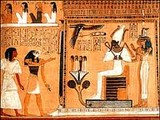 One personalized Book of the Dead was made for a 20)scribe named Ani who lived in Thebes about 1240 BC. It was translated by E. A. Wallis Budge注2 in 1895, and is considered a standard in the field of Egyptology. However, Budge cut the 78 foot scroll into 37 sheets of nearly equal size to make it easier to work with. Today the scroll is in the British Museum.
One personalized Book of the Dead was made for a 20)scribe named Ani who lived in Thebes about 1240 BC. It was translated by E. A. Wallis Budge注2 in 1895, and is considered a standard in the field of Egyptology. However, Budge cut the 78 foot scroll into 37 sheets of nearly equal size to make it easier to work with. Today the scroll is in the British Museum.
其中一部《亡灵书》是为一位名叫阿尼的书记官专门打造的,他生活在公元前1240年的底比斯。E·A·沃利斯·巴奇于1895年将它翻译出来,其译作被认为是埃及学领域的典范。然而,为了便于研究,巴奇把长78英尺(23.77米)的卷轴剪成37份差不多大小的小块。今天,这幅卷轴藏于大英博物馆内。
In Ani's scroll, we learn that his titles were “royal scribe and accountant of the 21)divine offerings of the gods.” Ani's wife was Thuthu, and she was a 22)priestess; she played a musical instrument in the temple. They were wealthy and important people.
在阿尼的书卷里,我们得知他的头衔是“宫廷书记官及天神祭品统计师”。阿尼的妻子叫图图,她是一位女祭司,在神庙内弹奏乐器。他们是富有的重要人物。
In the papyrus, Ani's journey has a good outcome. Horus, the son of Osiris, speaks up for him, and he's admitted into paradise.
根据纸莎草卷轴的描述,阿尼的旅程得到圆满的结果。奥西里斯之子荷鲁斯为他说好话,他获准进入天堂。
From their writings, including the Book of the Dead, we can get a sense that the ancient Egyptians were not so different from us. They thought about the meaning of life and about their 23)ultimate destiny. They believed that individuals are 24)accountable for their actions. And, like us, they hoped for peace and happiness in the end.
从他们的文字——包括《亡灵书》——我们可以感受到古埃及人其实和我们没有多大区别。他们也在思考人生的意义和最终的归宿;他们认为人应该对自己的行为负责。就像我们一样,他们希望终有一天会得到安宁和快乐。
